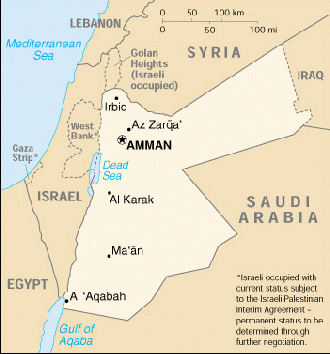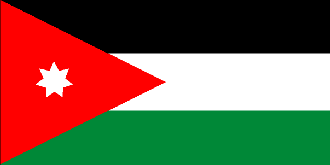
|
Jordan
Background:
King Hussein ruled Jordan for most of its history since independence from
British administration in 1946 (1953-1999). A pragmatic ruler, he successfully
navigated competing pressures from the major powers (US, USSR, and UK), various
Arab states, Israel, and a large internal Palestinian population, through
several wars and coup attempts. In 1989 he resumed parliamentary elections and
gradually permitted political liberalization; in 1994 a formal peace treaty was
signed with Israel. King Abdallah II - the eldest son of King Hussein and
Princess Muna - assumed the throne following his father's death in February
1999. Since then, he has consolidated his power and established his domestic
priorities.
Location:
Middle East, northwest of Saudi Arabia.
Area: Total: 92,300 sq km, water: 329 sq km, land: 91,971 sq km.
Area - comparative: Slightly smaller than Indiana.
Land boundaries: Total: 1,635 km, border countries: Iraq 181 km, Israel 238
km, Saudi Arabia 744 km, Syria 375 km, West Bank 97 km.
Coastline: 26 km.
Climate and Terrain:
Climate: Mostly arid desert; rainy season in west (November to April).
Terrain: Mostly desert plateau in east, highland area in west; Great Rift
Valley separates East and West Banks of the Jordan River.
Natural resources: Phosphates, potash, shale oil.
People:
Population: 5,307,470.
Ethnic groups: Arab 98%, Circassian 1%, Armenian 1%.
Religions: Sunni Muslim 92%, Christian 6% (majority Greek Orthodox, but some
Greek and Roman Catholics, Syrian Orthodox, Coptic Orthodox, Armenian Orthodox,
and Protestant denominations), other 2% (several small Shi'a Muslim and Druze
populations).
Languages: Arabic (official), English widely understood among upper and middle
classes.
Government:
Government type: Constitutional monarchy.
Capital: Amman.
Independence: 25 May 1946 (from League of Nations mandate under British
administration).
Economy overview:
Jordan is a small Arab country with inadequate supplies of water and other
natural resources such as oil. Debt, poverty, and unemployment are fundamental
problems, but King ABDALLAH since assuming the throne in 1999 has undertaken
some broad economic reforms in a long-term effort to improve living standards.
Amman in the past three years has signed on to an IMF agreement, practiced
careful monetary policy, and made significant headway with privatization.
GDP - composition by sector: Agriculture: 3.7%, industry: 26%, services:
70.3%.
Statistics:
Telephones - main lines in use: 403,000.
Telephones - mobile cellular: 11,500.
Radio broadcast stations: AM 6, FM 5, shortwave 1.
Radios: 1.66 million.
Television broadcast stations: 20 (plus 96 repeaters).
Televisions: 500,000.
Internet users: 210,000.
Railways: Total: 677 km.
Highways: Total: 8,000 km, paved: 8,000 km.
Airports: 18, with paved runways: 15, with unpaved runways: 3.
Heliports: 1.
Return to Visiting Locations
|

